
Astoria is a neighborhood in the western portion of the New York City borough of Queens. Astoria is bounded by the East River and is adjacent to four other Queens neighborhoods: Long Island City to the southwest, Sunnyside to the southeast, and Woodside and East Elmhurst to the east. As of 2019, Astoria has an estimated population of 95,446.

William Steinway, also known as Wilhelm Steinway, son of Steinway & Sons founder Henry E. Steinway, was a businessman and civic leader who was influential in the development of Astoria, New York City.
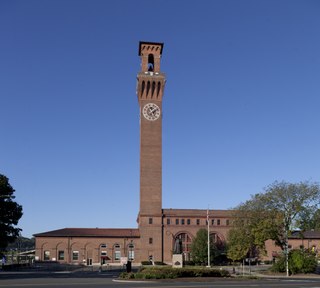
The Waterbury Union Station building is located on Meadow Street in the city of Waterbury, Connecticut, United States. It is a brick building dating to the first decade of the 20th century. Its tall clock tower, built by the Seth Thomas Company, is the city's most prominent landmark.
The Daimler Manufacturing Company (DMFG), was a boutique American automaker company from 1898 to 1907. From 1888 to 1898, the company was known as the Daimler Motor Company (DMC), formed under a partnership between Gottlieb Daimler of Daimler-Motoren-Gesellschaft and William Steinway of piano manufacturer Steinway & Sons. Headquartered in Long Island City, Queens, New York City near Steinway's Astoria headquarters, the company sold Daimler motors for yachts and launches, and goods vehicles including buses and trucks. It built and sold a single automobile model, the original American Mercedes.
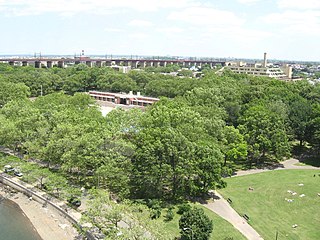
Astoria Park is a 59.96-acre (24.26 ha) public park in the Astoria neighborhood of Queens in New York City. The park is situated on the eastern shore of the Hell Gate, a strait of the East River, between Ditmars Boulevard to the north and Hoyt Avenue to the south. The Robert F. Kennedy (Triborough) and Hell Gate Bridges respectively pass over the park's southern and northern sections. Astoria Park contains a playground, a soccer field, a running track, a skate park, and courts for tennis, basketball, and bocce. Astoria Park also includes the Astoria Play Center, which consists of a recreation center and a pool. The park and play center are maintained by the New York City Department of Parks and Recreation.

Sohmer & Co. was a piano manufacturing company founded in New York City in 1872. Sohmer & Co. marketed the first modern baby grand piano, and also manufactured pianos with aliquot stringing and bridge agraffes, as well as Cecilian "all-inside" player pianos and Welte-Mignon-Licensee reproducing pianos. Sohmer pianos were owned by U.S. President Calvin Coolidge, and composers Victor Herbert and Irving Berlin. Sohmer is now a line of pianos manufactured by Samick Music Corporation in Korea.

Steinway Hall is the name of buildings housing concert halls, showrooms and sales departments for Steinway & Sons pianos. The first Steinway Hall was opened in 1866 in New York City. Today, Steinway Halls and Steinway-Häuser are located in cities such as New York City, London, Berlin, and Vienna.

The Ladies' Mile Historic District was a prime shopping district in Manhattan, New York City at the end of the 19th century, serving the well-to-do "carriage trade" of the city. It was designated in May 1989, by the New York City Landmark Preservation Commission to preserve an irregular district of 440 buildings on 28 blocks and parts of blocks, from roughly 15th Street to 24th Street and from Park Avenue South to west of the Avenue of the Americas. Community groups such as the Drive to Protect the Ladies' Mile District and the Historic Districts Council campaigned heavily for the status.

St. Monica's Church is a historic former Roman Catholic parish church in the Diocese of Brooklyn, located in Jamaica, Queens, New York. It was built in 1856 and is a brick basilica-type building in the Romanesque style. It features a four-story entrance tower in the center of its three-bay-wide front facade. Saint Monica's Church has been refurbished on the Campus of York College as a child care center.
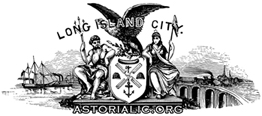
The Greater Astoria Historical Society (GAHS) is a non-profit cultural and historical organization located in the Astoria neighborhood of Queens, New York, United States, dedicated to preserving the past and promoting the future of the neighborhoods that are part of historic Long Island City, including the Village of Astoria, Blissville, Bowery Bay, Dutch Kills, Hunters Point, Ravenswood, Steinway Village, and Sunnyside.

The Sohmer Piano Building, or Sohmer Building, is a Neo-classical Beaux-Arts building located at 170 Fifth Avenue at East 22nd Street, in the Flatiron District neighborhood of the New York City borough of Manhattan, diagonally southwest of the Flatiron Building. Designed by Robert Maynicke as a store-and-loft building for real-estate developer Henry Corn, and built in 1897-98 it is easily recognizable by its gold dome, which sits on top of a 2-story octagonal cupola.

108 Leonard, formerly known as 346 Broadway, the New York Life Insurance Company Building, and the Clock Tower Building, is a residential structure in the Tribeca neighborhood of Manhattan in New York City, United States. Built from 1894 to 1898, the building was constructed for the New York Life Insurance Company. Stephen Decatur Hatch created the original plans while McKim, Mead & White oversaw the building's completion. The building occupies a city block bounded by Broadway to the west, Leonard Street to the north, Lafayette Street to the east, and Catherine Lane to the south. It is a New York City designated landmark and is listed on the National Register of Historic Places.
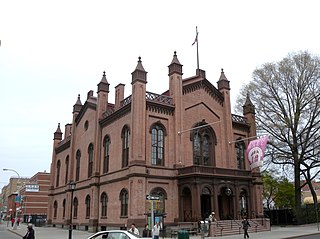
Flushing Town Hall is a historic Town Hall located on Northern Boulevard at Linden Place in the Flushing section of the New York City borough of Queens. Formerly, it served as the seat of government of the village of Flushing, established as Vlissingen in 1645, until the consolidation with New York City in 1898. It was built in 1862 and is a 2-story, three-by-six-bay, brick building with basement and attic. A style of architecture that originated in Germany, Rundbogenstil, was used here and in a number of American buildings of the Civil War Era. The earliest photographs show the building to have been painted a light color. The use of paint was discontinued following adhesion problems during a restoration. A small rear wing was added in 1938 containing a block of jail cells. The front facade features a triple arched portico topped by a classic entablature with low balustrade.

The Steinway Mansion is at 18-33 41st Street on a quarter-acre hilltop in the Astoria neighborhood of Queens in New York City.

P.S. 66 Jacqueline Kennedy Onassis School, formally known as Brooklyn Hills School, is a historic school building in Richmond Hill, Queens, New York. It was designed by architect C. B. J. Snyder (1860–1945) and built in 1898. It is a 2+1⁄2-story brick structure in the Romanesque style. It has a prominent, off-center tower with belfry. It features a slate roof and decorative stucco frieze. The school has a fortress-like appearance, including prominent round arches highlighting window openings, and a distinctive six-story tower. The building was restored in 2001 and remains in use as a New York City Public School.
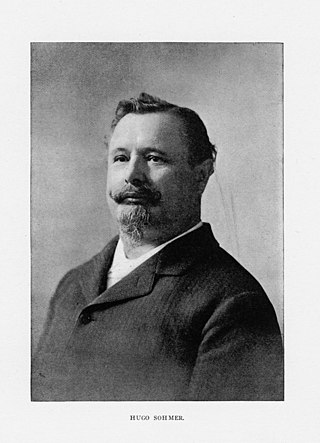
Hugo Sohmer was an American piano builder and manufacturer of German descent.
111 West 57th Street, also known as Steinway Tower, is a supertall residential skyscraper in the Midtown Manhattan neighborhood of New York City. Developed by JDS Development Group and Property Markets Group, it is situated along Billionaires' Row on the north side of 57th Street near Sixth Avenue. The main portion of the building is an 84-story, 1,428-foot (435-meter) tower designed by SHoP Architects and completed in 2021. Preserved at the base is the 16-story Steinway Building, a former Steinway & Sons store designed by Warren and Wetmore and completed in 1925, which originally carried the address 111 West 57th Street.

Sven is a residential building located at 29-59 Northern Boulevard in the Long Island City neighborhood of Queens, New York City. At 762 feet (232 m) tall, Sven is the second-tallest building in Queens behind Skyline Tower, as well as one of the tallest buildings in New York City outside of Manhattan.



















